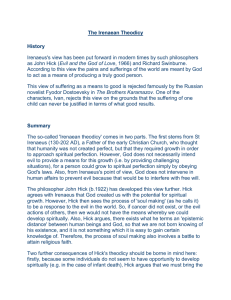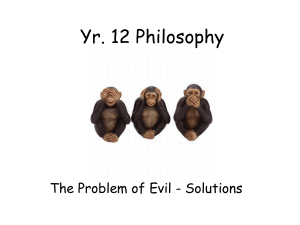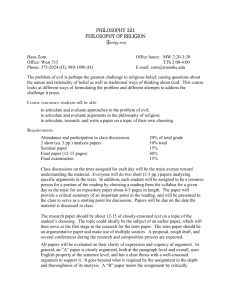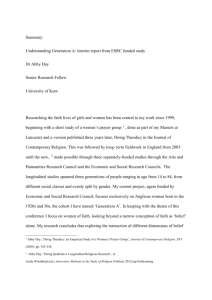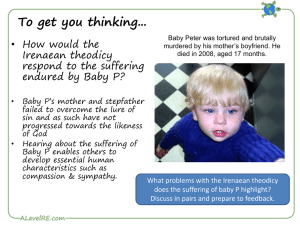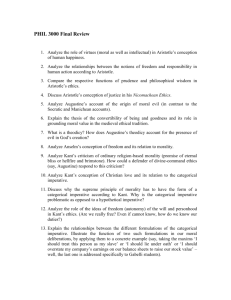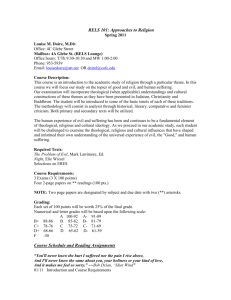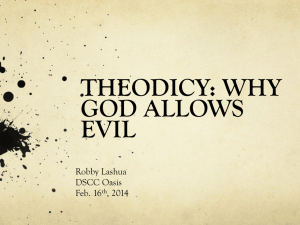Emilia Wrocławska-Warchala Cardinal Stefan Wyszynski University
advertisement
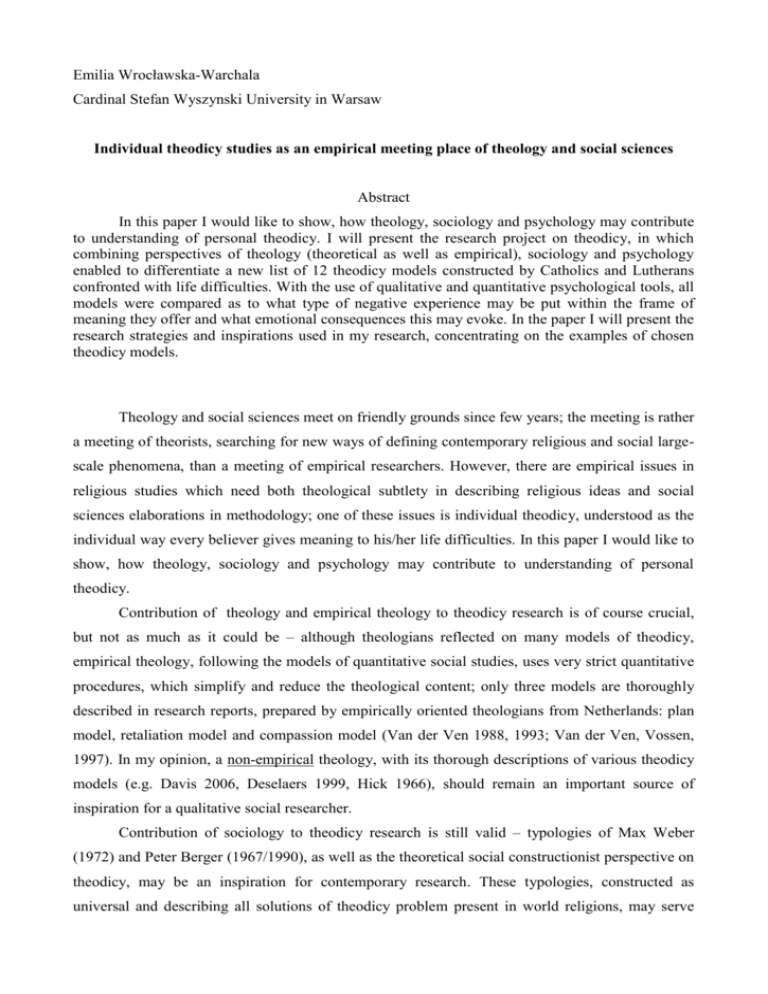
Emilia Wrocławska-Warchala Cardinal Stefan Wyszynski University in Warsaw Individual theodicy studies as an empirical meeting place of theology and social sciences Abstract In this paper I would like to show, how theology, sociology and psychology may contribute to understanding of personal theodicy. I will present the research project on theodicy, in which combining perspectives of theology (theoretical as well as empirical), sociology and psychology enabled to differentiate a new list of 12 theodicy models constructed by Catholics and Lutherans confronted with life difficulties. With the use of qualitative and quantitative psychological tools, all models were compared as to what type of negative experience may be put within the frame of meaning they offer and what emotional consequences this may evoke. In the paper I will present the research strategies and inspirations used in my research, concentrating on the examples of chosen theodicy models. Theology and social sciences meet on friendly grounds since few years; the meeting is rather a meeting of theorists, searching for new ways of defining contemporary religious and social largescale phenomena, than a meeting of empirical researchers. However, there are empirical issues in religious studies which need both theological subtlety in describing religious ideas and social sciences elaborations in methodology; one of these issues is individual theodicy, understood as the individual way every believer gives meaning to his/her life difficulties. In this paper I would like to show, how theology, sociology and psychology may contribute to understanding of personal theodicy. Contribution of theology and empirical theology to theodicy research is of course crucial, but not as much as it could be – although theologians reflected on many models of theodicy, empirical theology, following the models of quantitative social studies, uses very strict quantitative procedures, which simplify and reduce the theological content; only three models are thoroughly described in research reports, prepared by empirically oriented theologians from Netherlands: plan model, retaliation model and compassion model (Van der Ven 1988, 1993; Van der Ven, Vossen, 1997). In my opinion, a non-empirical theology, with its thorough descriptions of various theodicy models (e.g. Davis 2006, Deselaers 1999, Hick 1966), should remain an important source of inspiration for a qualitative social researcher. Contribution of sociology to theodicy research is still valid – typologies of Max Weber (1972) and Peter Berger (1967/1990), as well as the theoretical social constructionist perspective on theodicy, may be an inspiration for contemporary research. These typologies, constructed as universal and describing all solutions of theodicy problem present in world religions, may serve better these days even in studying Christians due to the social mobility and globalization, resulting in eclecticism of meaning. Closest to my own research interests is possible contribution of psychology to theodicy research. In this paper I would like to show, how in-depth interviews and qualitative analyses of phenomenological psychology (Giorgi 2003) and concepts of narrative psychology (Hermans, Hermans-Jansen 1995; Trzebiński 1992, 2002, 2005), as well as research strategies of culturally sensitive constructionist psychology of religion (Gergen and Gergen 1997), may be fruitful in studying personal theodicies: describing models used by contemporary believers, together with the subtleties of their meaning and narrative structure, the context of using them, their emotional content and “effectiveness” as well as their cultural specificity. In the narrative psychology it is supposed that all human experiences are put into the frames of the narrative. Constructing the story about difficult experiences we are formulating fabular justification of presented events – so we are creating our personal narrative theodicy. My proposal is to see story about difficult life experiences as the colloquial form of theodicy, natural form of everyday individual theodicy. Narrative theodicy is individual, but created in the context of a given religious culture. It is based on theodicy types present in this culture, especially those transferred in the form of a story. Particular theodicy types varies in narrative structure. General scheme of the narrative structure is presented in the Table 1, however every model of theodicy fulfill the structure in the specific way, with the specific content. The analysis of narrative structure may help to answer the question of why a given type of theodicy helps (or does not help) in dealing with negative experiences. Of special importance may be, if the theodicy type propose remedial actions and positive ending. Of crucial importance is what role in the narrative is ascribed to God (is he a helper, or maybe evildoer or a victim?) and to the narrator, “narrative me” (victim/evil-doer/helper). Presence of remedial actions and positive ending, as well as the way of constructing the role of God and narrator, may result in a special emotional meaning given to the experience. Table 1. General scheme of the narrative theodicy structure Theodicy elements Narrative equivalent „Unde malum?” Beginning of a plot („Whence evil?”) (critical event I) What is evil? Principal critical event (II) Who is suffering? Victim Who is responsible for evil? Evil-doer What are the consequences of evil? Adventures of characters introduced in the story How may we cope with evil? Remedial actions Who may cope with evil? Helper Is it possible to overcome evil? Ending My research project I began with an overview of the theological and philosophical literature on theodicy. In the literature I found the descriptions of following theodicy models: Evil as a lack of good theodicy (cf. Augustine, 1994; Hick, 1966) Human freedom theodicy (cf. Davis, 2006; Hick, 1966; cf. also theodicy described by Weber (1972) “we suffer for the sins of our ancestors”) Moral-esthetic theodicy (contrast theodicy) (cf. Augustine, 1994) God’s punishment theodicy (cf. Davis 2006, cf. also theodicy described by Weber (1972) and Berger (1967/1990) as retaliation theodicy) Transformation of evil into good theodicy (“means and ends approach”, cf. Davis, 2006; Swinburne; Hick, 1966) Vale of soul making theodicy (development theodicy; cf. Davis, 2006; Hick, 1966) God’s plan theodicy/ God’s will theodicy (cf. Alston, Davis, 2006) Compassion theodicy (Davis, 2006; Hick, 1966; Vossen, 1993) Relation with God theodicy (Deselaers, 2001; Hick, 1966) Struggle between good and evil theodicy (cf. Davis, 2006; Hick, 1966; Kay, 1998; Strange 1998; cf. also dualistic theodicies described by Weber (1972) and Berger (1967/1990)) Secular theodicies (cosmodicies) (Berger, 1967/1990; Van der Ven, 1988-1989) Then the probable narrative structure of the differentiated models were analysed. The next step was the empirical research among religiously active Christians. Research objective may be defined as exploring individual, personal way of experiencing and explaining evil and its relations to social knowledge as presented in the theological concepts of Christianity and Biblical narratives. Of special interest were the relations between emotional content of experience and its narrative form. Subjects were the religiously committed Christians belonging to two confessional groups: Catholics and Lutherans. Research was carried out in two regions: central Poland, dominated by Catholics, and in multi-confessional region, Cieszynian Silesia (Catholics from Warsaw (N=30), Catholics from Cieszynian Silesia (N=30) and Lutherans from Cieszynian Silesia (N=30)). I collected 369 narratives describing experiences of evil; 237 were analysed (according to the rule of analysing no more than 3 narratives of each person). Research method was as follows. Narratives were inspired and stimulated by the instruction encouraging the participants to talk about important experiences, perceived by them as the experiences of evil. Each experience was described by means of the list of feelings (by H.J.M. Hermans and Hermans-Jansen, 1995) to enable the analysis of its emotional content. Participants formulated valuation which were meant to describe the essence of the meaning of the experience. The questions concerning religious meaning of these experiences followed (e.g. questions concerning biblical stories which helped believers to give meaning to their experiences). The first step of the analysis was to correct the list of theodicy models described on the basis of literature review and differentiate models present in the narrative material. Then collected narratives were analysed by a group of independent judges (7 scholars specialising in narrative methods and/or in religious studies). Judges checked which theodicy types were present in stories and analysed their narrative structure. In the Table 2. there are presented differentiated theodicy types and its frequency in the narratives1. 1 Moreover, judges differentiated the types of meanings contended in stories; they formulated so called valuations (Hermans, Hermans-Jansens, 1995), which were compared to the valuations of the participants and serve to create typology of the experiences. Table 2. Theodicy models – frequency in the narratives of Catholics (N=60) and Lutherans (N=30) Theodicy models All narratives (n=237) God’s care theodicy 35 14,8% God’s plan theodicy 30 12,7% Relation with God 25 theodicy 10,5% God’s will theodicy 23 9,7% Devil’s action theodicy 19 8% Admonishment theodicy 10 4,2% Social influence theodicy 10 4,2% Compassion with God 8 Theodicy 3,4% Forgivness theodicy 7 3% Struggle between 7 good and evil theodicy 3% God’s law theodicy 3 1,3% P- asympthotic significance (bilateral) N-number of research participants n- number of collected narratives Catholics (n=158) 26 16,5% 19 12% 19 12% 15 9,5% 17 9,8% 9 5,7% 5 3,2% 4 2,5% 2 1,3% 5 3,2% 2 1,3% Lutherans (n=79) 9 11,4% 11 13,9% 6 7,6% 8 10,1% 2 2,5% 1 1,3% 5 6,3% 4 5,1% 5 6,3% 2 2,5% 1 1,3% Chi-square test Value (df=1) 1,073 P 0,172 0,679 1,096 0,295 0,024 0,877 4,835 0,028 2,558 0,110 1,305 0,253 1,035 0,309 4,711 0,030 0,074 0,786 0,000 1,000 0,300 Among the most frequently constructed theodicies they were some described in the theological literature, like God’s plan theodicy, relation with God theodicy and God’s will theodicy, but also specific narrative models, like God’s care theodicy, devil’s action theodicy or admonishment theodicy. The last model may be seen as a modified version of God’s punishment theodicy with the elements of development theodicy. I would like to concentrate on this model, previously describing the classical punishment model and development model to show how they are combined in the model found in my own research. Punishment theodicy, called also retaliation theodicy (Weber 1972, Berger 1967/1990) is present in Judeo-Christian culture since centuries, and it is strongly enrooted in Bible narratives (e.g. stories about original sin, deluge, Sodoma and Gomorrah) as well as in the secular legal system (Davis, 2006). According to this theodicy human suffering is seen as the result of sin – as a justly imposed punishment. Development theodicy, described by Richard Swinburn and John Hick (1966), is according to this authors present in Christian tradition since the works of Saint Ireneus of Lyon; John Hick calls this model „the minority theodicy”, because it was never the main or central theodicy, however, since 19th century is supported by the secular narrative of evolution and may be more frequent among believers than it ever used to be in the history of Christianity. According to this model, all misfortunes are interpreted as the impulses for moral development; only pain and suffering (of individual and other people) may enable developing moral attitude; confrontation with suffering of others place individual in the position of choosing: hurt or help other people. According to the model of admonishment theodicy God through the negative events tries to show to the victims the right way in life, to strengthen faith of man, to draw his/her attention to the spiritual dimension of life. To demonstrate the difference between classical punishment theodicy and admonishment theodicy I would like to show some examples of narratives. The first example is a unique one among collected narratives; it represents classical version of punishment theodicy, not popular among religiously engaged Christians. Catholic man, Warsaw „In America there was a hurricane, in a city, what was its name, not Montreal, but… I am not sure, however, there was a flood two years ago, it was completely destroyed… And someone said to me that it was a hotbed, prostitution, pornography, whatever you may, a Mecca of evil. It was completely destroyed. This is quite interesting, God sometimes is angry about this type of situations, and reacts.” As you can see, in the narrative the victims are people with whom narrator does not identify himself with. Narrator ascribes to God a role which may be called a role of an “evil-doer” – God is responsible for the tragic natural event. He does not help victims, he only inflicts just punishment. There is no perspective of positive ending (at least from the perspective of the victims) nor possible remedial actions. Now I would like to present the modified variations of punishment theodicy – which I call admonishment theodicy (in Polish “teodycea napomnienia”), because within this model of narrative God is not punishing, but rather admonishing men. In the first narrative this theodicy is used to predict future solutions of the family problems, in the second the theodicy is used to interpret the individual experience as an impulse to personal development. Catholic woman, Cieszynian Silesia Experiencing alcoholism in a family (threat to the bond) „Sometimes my mother says this way. About my brother and his wife. Something bad has to happen to make them come to their senses! This is what my mom says. Always: there have to be some accident, some disaster, to make M. come to his senses. To make him stop drinking, find a job… Someone has to die, someone has to pass away. This is it.” In this narrative the role ascribed to God is more beneficial than in a previous one. Although he may decide to experience a hero of narrative (potential victim) with suffering, he is doing so to enable him changing his life; it is clear that a potential intention of God is not only to do justice. Suffering is here seen as purposeful. This narrative bears some resemblance to the “vale of soul making” model. The next narrative is even closer to the model of development theodicy. Catholic man, Cieszynian Silesia Experiencing car accident (threat to the sense of continuity of the self) „It means, something what moved me most, in the physical way… As well as emotionally, spiritually, this is a one situation, car accident I participated in (…) As I said, looking from one side it destroyed my emotional, psychic balance, but from the other side it showed me my weakness if relations with God are concerned, I was then not on a very good terms with God, sometimes I cared about God’s commandments, sometimes I did not. This accident moved me in a spiritual way. I get off the car and I thought: it is so important to be in a state of sacramental grace in this type of circumstances, I have to do something about it. So this experience was creative in a way, I could say, aimed at something.” In this narrative life-threat due to car accident is seen as the motive helping to change lifestyle, to decide to be a “better Christian”. The role of the narrator is active – it is his choice to change his life. There is no clear ascription of the accident to the God’s action or will, although it is seen as serving God’s ends. The focus is on changes which occurred due to the accident – moral development. These specific elements of the narrative structure (beneficial role of God; in some narratives also an active role of man as helper, dealing with evil; at least potential positive ending) make this model very different from the traditional version of punishment model, closer to the “vale of soul making” model, and have some consequences for the emotional content of the experiences put into the frame of this theodicy model. These experiences are characterized with higher intensity of positive feelings (joy, satisfaction, pleasure, sense of security) and higher intensity of the feelings connected with strengthening relations with others (love, care, tenderness, intimacy) comparing to the experiences without reference to this model. H.J.M. Hermans (1995) calls emotional pattern with the prevalence of these feelings the experience of “Unity and love”. So the admonishment theodicy makes the negative experience closer to the “Unity and love” pattern. The statistical analysis showed, what types of experiences may be put into the frames of the admonishment theodicy. These were: threat to the bond due to natural causes (death, illness) as well as threat to the sense of continuity of the self – the second type also connected with the natural evil, not the social one. The second example of car accident was typical for this theodicy model. In fact, threat to the bond due to the social factors was negatively connected with this model, which may mean that admonishment theodicy does not serve very well as the interpretive frame of social evil (although the first example shows that sometimes it may be used also in this context, but then the admonishing activity of God is still to come and is not described as the main evil). The second example shows, that using this model may even transform social evil into natural one; the narrator in the first part of the story (not quoted here) was telling about being angry with thoughtless behavior of the driver who was responsible for the accident; but he said also, that seeing the accident as the opportunity to grow in spiritual way changed his perspective – he no longer thought about blaming the other driver. We may suppose that focusing attention on spiritual, not social dimension of event enabled the narrator to experience car accident more like the “Unity and love”. We may conclude, that narrative theodicy may not only give new dimension of meaning to the experience, but maybe even completely change this meaning. Summing up, what are the profits from combining perspectives of theology and social sciences in theodicy studies? If we will take the research method from psychology, in-depth narrative interview may enable to differentiate specific models of individual theodicy. Theology in its turn will enable to describe them with appropriate sensitivity to the subtleties of religious meanings and compare to the models present in academic theological discourse. Thanks to the psychological method of analysis models may be compared as to the specific context (type of experience) they may be used and to the emotional consequences of using them. In this text there is no place for the detailed description of all differentiated theodicy models; very brief one is given in Table 3. I think that even this brief description shows the interesting possibilities which are open for the scholar motivated to combine theology and social sciences in theodicy studies. Table 3. The specificity of theodicy models Theodicy model Structure2 God’s care theodicy Positive ending; Me as a victim; God and me as helpers; remedial actions God’s plan theodicy God as helper; remedial actions Relation with God Theodicy Positive ending; God and me as helpers; remedial actions God’s will theodicy Devil’s action theodicy 2 Me as victim; Me as helper Meaning of experiences3 Emotional content4 Positive connection: Stronger positive Threat to the self; feelings; Threat to the sense of continuity of Stronger feelings the self; connected with threat to the sense of identity; the motive of contact Negative connection: Threat to the bond; Threat to the bond due to social causes (inner conflict). Positive connection: Stronger positive Experience of threat to the bond due feelings; to natural causes (death, illness); Stronger feelings connected with Negative connection: the motive of Threat to the bond due to social contact causes (lack of care) Positive connection: Stronger positive Threat to the self; feelings; Threat to the sense of continuity of Weaker negative the self; feelings; Negative connection: Threat to the bond; Threat to the bond due to social causes (inner conflict) Positive connection: Stronger positive Experience of threat to the bond due feelings; to natural causes (death, illness); Threat to the self; Threat to the sense of dignity; Negative connection: Threat to the bond; Threat to the bond due to social causes (inner conflict) Devil as evil-doer; Positive connection: Stronger positive Me as helper; threat to the sense of identity feelings; Remedial actions Chi-square test comparing presence of a given element of structure in the narratives with a given model and without reference to it, significance p<0,1. 3 Chi-square test comparing descriptions of a given meaning in the narratives with a given model and without reference to it, significance p<0,1. 4 Mann-Whitney test comparing the intensity of feelings in describing the narratives with a given model and without reference to it, significance p<0,1. Theodicy model Admonishment theodicy Structure Positive ending; God and me as helpers; Remedial actions Social influence Theodicy Child as victim Compassion with God theodicy God and me as helpers; Remedial actions Remedial actions Forgivness theodicy Fight of good and Positive ending; evil theodicy God as helper; Remedial actions God’s law theodicy Me as victim Meaning of experiences Emotional content Positive connection: Stronger positive threat to the bond due to feelings; natural causes (death, Stronger feelings illness); connected with the threat to the sense of motive of contact continuity of the self; Negative connection: Threat to the bond due to social causes (inner conflict) Stronger positive feelings; Stronger feelings connected with the motive of contact - Positive connection: Experience of threat to the bond due to social causes (inner conlict) Positive connection: threat to the self; threat to the sense of continuity of the self; threat to the sense of identity - - Stronger positive feelings; Weaker negative feelings Positive feelings: joy, pleasure, satisfaction, sense of security Negative feelings: anxiety, shame, guilt, sense of inferiority Feelings connected with the motive of contact: love, care, tenderness, intimacy References: Augustine (1994). Confessions. (tr. by A.C. Outler). Accessible on the Internet 6 April 2012: http://www.fordham.edu/halsall/basis/confessions-bod.asp Berger, P.L. (1967/1990). Sacred Canopy. Elements of sociological theory of religion. Garden City, New York: Anchor Books. Davis, B. (2006). The reality of God and the problem of evil. London, New York: Continuum. Deselaers, M. (2001). „Und Sie hatten nie Gewissensbisse?“: Die Biographie von Rudolf Höß, Kommandant von Auschwitz, und die Frage nach seiner Verantwortung vor Gott und den Menschen. 2., neubearbeitete Auflage. Leipzig: Benno-Verl. Furnham, A., Brown, L.B. (1992). Theodicy: A Neglected Aspect of the Psychology of Religion. Journal for the Psychology of Religion, 2(1), s. 37-45. Gergen, M.M., Gergen, K.J. (1997). Toward a Cultural Constructionist Psychology. Theory and Psychology, 7, s. 31-36. Giorgi, A. (ed.), (1999). Phenomenology and psychological research. Pittsburgh: Duquesne University Press. Hermans, H.J.M., Hermans-Jensen, E. (1995). Self-Narratives. The Construction of Meaning in Psychotherapy. New York, London: The Guilford Press. Hick, J. (1966). Evil and the God of love. London, Melbourne, Toronto: Macmillan. Hutchison, J.F.W., Greer, J.M., Ciarrocchi, J.W. (1999). An empirical exploration of concomitants of Vossen’s theodicies in a population of elderly women. Journal of Empirical Theology, 12 (2), s. 23-34. Hutsebaut, D. (2003). Theodicy models, religious coping strategies, self-image and post critical belief. An empirical study on a sample of Dutch-speaking Belgians. Archive für Religionpsychologie, Band 24, s. 75-84. Kay, W.K. (1998). A demonized worldview: dangers, benefits and explanations. Journal of Empirical Theology, 11 (1). Strange, W. (1998). Dispensing with the Devil. Reflection on Kay. Journal of Empirical Theology, 11 (1), s. 30-36. Śleszyński, D. (1998). Wędrówka doświadczenia. Podejście fenomenologiczne i egzystencjalne. Białystok: Trans Humana. Trzebiński, J. (2002a). Narracyjne konstruowanie rzeczywistości. W: J. Trzebiński (red.) Narracja jako sposób rozumienia świata. Gdańsk: GWP, s. 17-42. Trzebiński, J. (2002b). Autonarracje nadają kształt życiu człowieka. W: J. Trzebiński (red.) Narracja jako sposób rozumienia świata. Gdańsk: GWP, s. 43-80. Trzebiński, J. (2002c). Wstęp. W: J. Trzebiński (red.) Narracja jako sposób rozumienia świata. Gdańsk: GWP, s. 13-16. Uchnast, Z., Iskra, J. (2003). Doświadczenie cierpienia: jakościowa analiza zdarzeń życiowych. W: Krzysztof Krzyżewski (red.) Doświadczenie indywidualne. Szczególny rodzaj poznania i wyróżniona postać pamięci. Kraków: Wydawnictwo UJ, s. 143-172. Van der Ven, J.A., (1988). Practical Theology: From Applied to Empirical Theology. Journal of Empirical Theology, 1 (1), s. 7-27. Van der Ven, J.A.,(1993). Practical theology: an empirical approach. Kampen: Pharos. Van der Ven, J.A., Vossen, E. (1997). Education for coping with suffering. Journal of Empirical Theology, 10 (1), s.61-83. Van Uden, M.H.F., Pieper, J.Z.T., Alma, H.A. (2004). Bridge over troubled water: Further results regarding the receptivity coping scale. Journal of Empirical Theology, 17, s. 101-114. Vermeer, P., Van der Ven, J., Vossen, E. (1996). Learning theodicy. Journal of Empirical Theology, 9 (2), s. 67-85. Vossen, H.J.M.E. (1993). Images of God and Coping with Suffering. The psychological and theological dynamics of the coping process. Journal of Empirical Theology, 6, s.19-38. Weber, M. (1972). Wirtschaft und Gessellshaft. Grundriss der Verstehenden Soziologie. Tübingen: J.C.B. Mohr (Paul Siebeck).
